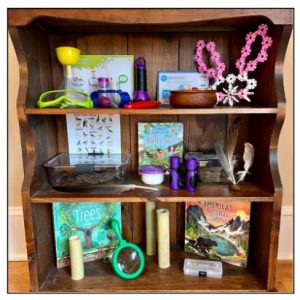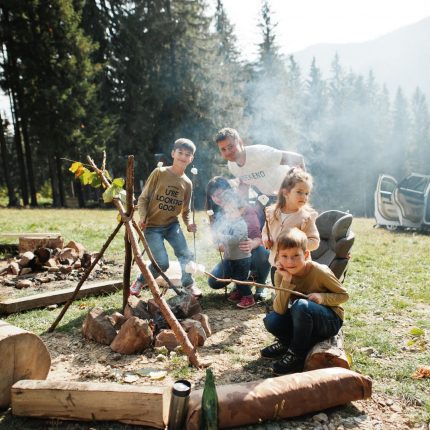This post is sponsored by Little Monsters Universe.
I’m Tina Salmanowitz, an advocate for homeschooling and science education. With over a decade of experience as a science educator (in class and at home), I know firsthand the joys and challenges of guiding young learners through scientific exploration. Motivated by my passion for fostering a love for learning, I founded Little Monsters Universe (LMU), which has resources, science lessons, and support for homeschooling families.
In this blog, I will help you navigate the world of homeschool science education with confidence and enthusiasm. Whether you’re just starting your homeschooling journey or seeking fresh inspiration to invigorate your science curriculum, I’m here to support you every step of the way.
Embracing Curiosity
For those who may feel under-qualified, let me reassure you that you’ve got this! One of the most powerful ways to nurture your child’s curiosity is by modeling it yourself. Show them that you are eager to learn alongside them by asking questions, seeking answers, and exploring the world together.
Science is all about curiosity and investigation, and sharing that journey with your child is incredibly rewarding. As you explore together, remember to create a safe space where mistakes are seen as opportunities to learn and grow. Modeling resilience and a positive attitude towards setbacks will encourage your child to persevere in the face of challenges.
For example, when we first tried growing plants in our greenhouse, things didn’t go as planned. We didn’t get the amount of fruits and veggies we hoped for. But instead of giving up, we treated it as a chance to learn together. Our kids saw how we faced problems head-on and didn’t let them stop us. We showed them that making mistakes is okay and that we can learn from them. Over time, we made changes to our greenhouse setup and kept trying. This experience taught our children that it’s okay to fail sometimes and that it’s all part of getting better at things. Now, they’re more willing to take on new challenges and not be afraid of making mistakes.
Setting the Stage for Success
Creating a science-friendly environment at home is essential. From my own experience, I’ve noticed a significant difference in my children’s engagement when they have easy access to materials for exploration. When I kept our science supplies tucked away in a closet, they were rarely touched unless I initiated an experiment. However once I moved them to a space where the kids could reach them and explore freely, I witnessed spontaneous investigations happening without my prompting.
In our home, I like to have a variety of materials readily available for my kids to use, such as:
- Open-ended building and craft supplies,

- Recycled materials that can spark creativity,
- Natural elements such as leaves, rocks, and shells, which add a hands-on element to our explorations,
- Basic science tools such as magnifying glasses, binoculars, and measuring cups, are great for making observations and conducting simple experiments.
One thing I’ve found particularly beneficial is having an area to display my kids’ projects and discoveries. Not only does it reinforce the importance of their findings, but it also boosts their confidence and encourages them to delve deeper into their explorations. Seeing their work proudly showcased motivates them to continue exploring and learning.
By creating a space where kids feel encouraged and empowered to explore, we lay the foundation for a lifelong love of science. It’s amazing to see how something as simple as rearranging our materials can make such a big difference in fostering curiosity and promoting hands-on learning.
Fostering Kid-Led Learning
Encouraging your children to pursue their interests is key to fostering curiosity and a love for learning. Pay attention to their wonderings and questions, and make a habit of writing them down. While some families create a “Wonder Wall” to display these questions, we prefer using a journal as it’s more convenient and takes up less space.
In our busy lives, we may not always have the time to explore every question right away. However, by recording their inquiries, we create a valuable resource for future learning opportunities. It also sends a powerful message to children that their questions are important and worthy of exploration, ultimately nurturing a mindset of curiosity that will serve them well as they grow.
Developing Skills to Think Like a Scientist
Ultimately, our goal is to foster skills that will help our children think like scientists. 
Here’s an example from our home. It began with a simple question: “What makes a rainbow?” When time allowed, we embarked on an experiment. I set up a model using water and mirrors for them to explore and investigate. They tinkered with variables, altering the length and intensity until they produced their own rainbows. Next, we practiced our communication skills by discussing our findings and observations. Finally, we drew conclusions based on our experiment.
This hands-on approach allowed them to not only understand the science behind rainbows but also develop critical thinking and analytical skills essential for scientific inquiry.
Introducing Little Monsters Universe
At Little Monsters Universe, we’re passionate about fostering a love for science in young minds. Our comprehensive homeschooling curriculum is designed to ignite curiosity, stimulate imagination, and cultivate critical thinking skills. With engaging lessons, hands-on activities, and interactive resources, we empower children to explore the wonders of the natural world and discover their potential as budding scientists.
Teaching science at home is an enriching experience that lays the foundation for a lifelong love of learning. By creating a science-friendly environment, incorporating hands-on activities, and fostering a culture of curiosity, you provide children with the tools and opportunities they need to thrive academically and personally. With dedication, creativity, and support, you can inspire the next generation of scientists and innovators right from the comfort of your own home. Consider starting your journey with our Nature Bundle, a comprehensive resource designed to make learning enjoyable and accessible. It offers a wide array of easy-to-use activities and lessons that encourage outdoor exploration and provide year-long engagement with the wonders of the natural world.
Grab a 15% Discount on Little Monsters Universe at the Homeschool Marketplace!
Latest Posts

As homeschooling continues to grow in popularity, more parents are taking on the challenge of providing a comprehensive education that not only meets academic standards but also prepares their…
Read more >
June has come and gone, and summer is in full swing! Whether you're traveling this summer or staying close to home, we hope you're enjoying this time with your family. We wanted this month's…
Read more >
Summer is an all-around favorite season for most people. In the U.S., it’s even more exciting for many of us since we get to celebrate Independence Day! The Fourth of July is a wonderful…
Read more >


